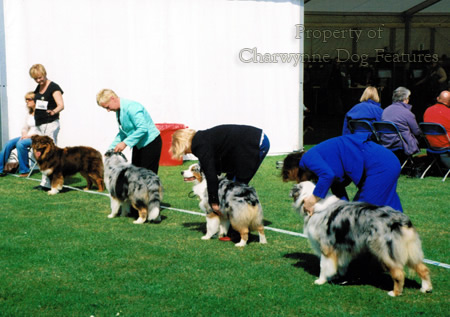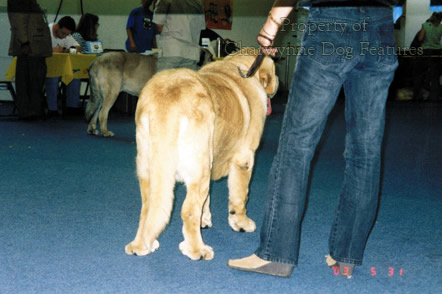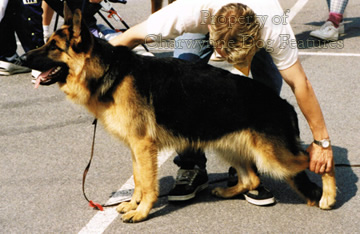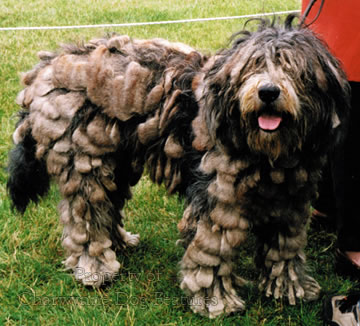852 SHEPHERDS' DOGS - OUT OF SORTS
SHEPHERDS' DOGS - OUT OF SORTS
by David Hancock
 Lack of Condition
Lack of Condition
“Taking the dogs all through there was but little fault to be found in the matter of coat, though the tendency was perhaps to quantity at the expense of texture. There were also too many heads of the narrow greyhound type, with insufficient space for brains. Many of the bitches, too, were fat.”
JA Doyle in his critique on Collies at The Crystal Palace Dog Show, reported in The Kennel Gazette of February, 1884.
Border Collies, Ch Show, 2011: “The founders of the BCC of GB (Border Collie Club of Great Britain, DH) were among the group of dedicated people who worked very hard to devise a Standard that described a sound, fit, working dog and this is reflected in the fact that this Standard uses such phrases as ‘impression of endurance’, athletic body’, and ‘muscular hindquarters’. I struggled to find more than a handful of dogs who were in a reasonable working condition; most of them being considerably overweight and lacking in muscle tone.”
Border Collies, Ch Show, 2013: “It was noticeable that there appears to be less depth of quality in the breed than in the past…Some dogs were far too fat and this affected their movement and outline.”
Those three critiques, a century apart, indicate at once the immediate distaste for exhibitors’ sending unfit dogs into the show ring. Spending a day at the National Working Breeds Dog Society's 24th Group Championship Show at Malvern a decade ago left me quite shocked - by the physical condition of far too many of the exhibits. Is this not the show of the year for those breeds that were meant to work? I use the word 'shocked' quite legitimately because, if the breeders, the exhibitors and especially the judges are prepared to go along with this situation, there is something fundamentally wrong - with worrying possibilities for the future.
Of those who argue that such a show is just a beauty contest and the condition of the dogs an afterthought, let me ask a couple of questions. Firstly, when did you ever see a national beauty queen with a spare tyre and podgy limbs? Secondly, what is the point of having a serious hobby if you don't take it seriously, especially if you want to win? And thirdly if exhibits are expected to be in "show condition", why are judges taking a different view? I was also disturbed to watch four successive classes of one breed being 'judged', without the exhibits' feet once being examined. The bite of each dog was checked and infinite care taken over the comparative assessment of the entry. But feet are crucial to working breeds, as stressed earlier, more important even than mouths. Why does the organisation inviting the judge invite such an inadequate individual?
Importance of Definition
But what is actually meant by the expression 'show condition'? The Kennel Club's Glossary of Terms defines condition as: "Health as shown by the body, coat, general appearance and deportment. Denoting overall fitness." Not brilliantly written but the last phrase is the key one. Frank Jackson, in his most useful "Dictionary of Canine Terms", defines condition as: "Quality of health evident in coat, muscle, vitality and general demeanour." Harold Spira, in his "Canine Terminology", describes it as: "An animal's state of fitness or health as reflected by external appearance and behaviour. For example, muscular development..." The Breed Standards and Stud Book Sub-Committee at the KC inform me that show condition indicated an expectation of "a dog in good health as indicated by good coat condition, good muscle tone, a bright eye and up on the feet", adding that any competent judge would know this. One thing is inescapable in the interpretation of these definitions, condition means fitness as demonstrated in the dog's muscular state.
Why then, at the working breeds show of the year, were judges putting up dogs in poor muscular condition and quite clearly not fit? Is it ignorance, incompetence or indifference? Some of the judges I watched simply did not know soft muscle from hard and seemed incapable of detecting the absence of muscular development. I shudder to think where this will lead us! Judging livestock is essentially a subjective skill based on what you see in the entry not what the exhibitor wants you to see. Rather than a reaction to the animal before you, it is more a conscious action to relate the animal presented to you in the ring to the beau-ideal for that particular breed.
Undesirable Impression
If we are going to accept unfit exhibits lacking muscular development as challenge certificate material, then novice exhibitors are being given a wholly undesirable impression and standards have already become unacceptably low. We are in effect betraying the work of the skilful pioneer breeders who handed these fine breeds down to us. That apart, where is the pride of the breeders, owners and handlers concerned? Who admires a puny, unfit, under-developed dog or an obese flabby one? These breeds were designed to work! What sort of encouragement is this to those admirable exhibitors who spent hours getting their dogs into real show condition?
In his book All About the Bull Terrier of 1973, the much-missed Tom Horner (an excellent judge of pastoral and working breeds) recorded: "A wise breeder puts on show only his best stock and presents them in the peak of condition, physically fit, clean and trained to show off their points". Are we losing our way as we lose our most experienced, most knowledgeable, most informed judges? There were not many dogs at that show at Malvern in mid-July in the peak of condition. There were far too many demonstrably not physically fit. Some of these were actually favoured by the judges. If this is the case at a show of this standing, where will it all end - with prizes for fat dog of the day?
In his informative The Practical Guide to Showing Dogs of 1956, Captain Portman-Graham wrote: "The fact that a dog is structurally sound is not in itself sufficient to ensure that it will always win at shows. It is of paramount importance that it must be...at the highest standard of condition. Perhaps one of the biggest advantages which dog showing confers on the dog as an animal is the care which must be bestowed upon it." If unfit dogs with poor muscular condition can win at dog shows, then the whole argument that such shows improve dogs is totally destroyed. Dogs which are inadequately exercised and merely wheeled out for the next show can be so easily identified by any competent judge and quickly thrown out of the ring that such an insidious practice, both for dogs and the dog game, can be ended. Are our current crop of judges up to this?
Appreciating Appearance
The esteemed Portman-Graham went on to write: "...exercise is a vital consideration in maintaining any breed of show dog in bloom, health and vigour...When one watches the beautiful muscles of a racehorse one sees a similarity between a dog's muscles which have been developed correctly and naturally, and ripple in movement. Yet there is evidence of lack of muscular tone and development in many show breeds today." He would not have liked the rings at the championship dog shows of today. Surely such a show should be didactic not merely epideictic; in other words it has a role in teaching those wanting to learn not just being conducted literally for show. A dog show, properly conducted, should attract exhibitors not exhibitionists.
But what are the reports from other shows producing on this theme? Here are extracts from some: Bearded Collie dogs - "So many dogs were lacking in muscle tone - does no one exercise their dogs anymore?" Rottweiler bitches - "A Rottweiler is classed as a herding breed, they are supposed to herd cattle not look like them..." Rough Collie bitches (at Crufts) - "But I was faced with many, very fat, cloddy shaped bitches, who because of the fatness...moved so badly". I would go further than the last judge and state that surplus flesh can only do harm. Nowadays we are bombarded with verbal and written instructions from a host of nutritionists and crafty manufacturers at shows yet I see more fat dogs these days than ever before. We all know that an overweight dog is an unhealthy dog. If exhibitors produce unhealthy dogs in the ring then every judge has a duty to point this out and decline entry to such exhibits. If a judge does not take this course of action, then a complaint should be made to the KC. This wholly undesirable situation in which unfit unhealthy dogs are allowed in show rings simply cannot be condoned.
Those who exhibit dogs in a show ring have a distinct role in demonstrating to the public what the pedigree breeds should look like when presented, in show condition, to the judge. Their dogs should be exemplars of cosmetic excellence. The public as spectators, and novices as students, should not only admire what they see in the ring but be guided by the standards there. If an exhibit needs a good bath, it should, in rugby league parlance, be sent for an 'early bath'. If its claws need cutting, its teeth need cleaning, its coat needs unmatting and its eyes and ears need a thorough wipe, then the exhibit is not ready for its class and should be banished until it is. Soft-muscled and overweight dogs however pose a much more important, more long term problem.
Killing by Kindness
Writing in the Summer 1995 number of "You and Your Vet", Simon Wolfensohn, a vet worth heeding, recorded that three out of every ten pet animals are overweight and that more pets are killed by misplaced kindness than are starved. He identified the concomitant health problems: fatty deposits around the heart, fat damage to the liver, weakness of muscles caused by fat deposits, diabetes and even arthritis because of the increased burden on the joints. He cited the cases of a Bouvier des Flandres that weighed 132lbs (the weight of two Bouviers on one set of legs) and of a German pointer of 95lbs, roughly twice her desired weight.
If you purchase an expensive pedigree dog, why try to feed it to death? If you spend time and money breeding and exhibiting pedigree dogs, why frustrate yourself by putting dogs in the ring that cannot win? I should hastily add "should not win", for the judge makes this differentiation. Ninety years ago, Theo Marples, writing in his "Prize Dogs", put the condition of a dog in the ring ahead of its ability to 'show'. He also wrote "It is always best not to show a dog in bad condition, even although he may be entered for a show. Many a good dog has met defeat and tarnished his reputation by being exhibited in indifferent condition". I see dogs "in indifferent condition" being presented to the judge at most of the shows I go to. What folly! Some of the owners of such dogs moan later about the standard of the judging when their dogs fail to gain a place. Winning is all about the pursuit of excellence, not just turning up on the day.
Are soft-muscled overweight exhibits now actually becoming acceptable at shows? If so, then we have not only too many incompetent judges but a potential disaster on our hands. For, if, as is claimed, the improvement of dogs is the Kennel Club's mandate and dog shows are the vehicle for this, then permitting soft-muscled overweight dogs even to enter the ring substantially undermines this claim. Pedigree dog shows, and Pastoral and Working Breed shows in particular, must demonstrate to the dog-owning public what each breed should look like in peak condition. If this is not happening, then the whole credibility of pedigree dog breeding is put at risk. There is now an urgent need for us to exercise our minds as well as our dogs.
Damned by Judges
At the 2005 Crufts, this judge's comment was made on Pyrenean Mountain Dogs – “There was a total lack of condition in some dogs, many were grossly overweight, so obvious when moving and they paid the penalty.” Those last four words are important. What really is the sense in exhibiting a good dog, when its condition ensures that it can't win? Eight years later, the 2013 Crufts judge reported, on Rough Collies (dogs): “…there is still problems (sic) with movement and weak pasterns but I do believe this is environmental not hereditary” In other words the dogs were insufficiently exercised and out of condition. At Crufts in 2011, the Collie judges found that, in Smooths: “the lack of muscle-tone and conditioning on quite a number of exhibits;” and in Roughs: “I found bad movement in a few of the classes. A Rough Collie should be able to move with drive…” If the judge knows that basic fact, why don’t the exhibitors? At this same show, the Old English Sheepdog judge observed that: “Movement is a concern as many cannot move soundly and with drive; cow-hocked can also be seen on the move and standing. We are getting quite a few dogs that have little or no muscle on the rear thighs. This breed should be able to work all day; many would not last for long free running.” What a damning comment at our premier show where dogs have to qualify to compete there.
For comments like this to be passed by top judges on top exhibits is alarming. The Kennel Club tell us that this canine showcase displays 'the best of the very best' .How can the flab be fought when our top show is for unfit dogs and our leading animal charity has it in for fit dogs? The Kennel Club could lead the way by advising judges to omit from their deliberations any exhibit not in show condition, with obesity a disqualifying fault. In his admirable The Practical Guide to Showing Dogs of 1956, Capt R Portman-Graham wrote: “I am convinced that in pre-war days any favourable comments passed on my dogs' fronts could be attributed to the systematic special exercises they were given in order to develop their muscles naturally...!”
The writer was clearly dedicated to the improvement of his dogs; his past work should now be overtly supported by the Kennel Club with a clear statement on overweight exhibits at shows licensed by them. It is not good enough to hide behind judges, the top body in the world of pure-bred dogs should set out its stall. Under-exercised overweight dogs should not even be considered by show ring judges. This would have an enormous effect on exhibitors and do an enormous amount of good for the healthier dog movement. With fat dogs appearing at Crufts, how do we campaign against the most widespread threat to dogs - obesity? Appeal to the dog food manufacturers? I don't think so. Appeal to the owners? Unrewarding, in my experience. Killing by kindness is not an emotive issue; it is probably condoned by the morally vain. Involve the veterinary profession? Not if the food being sold in so many surgeries these days is anything to go by. Educate the future generations? They are struggling with obesity themselves if the high street is any indicator. 
In our allegedly more compassionate society, when, in the distant future, any dog capable of heeling, herding or guarding has become redundant and working dogs are unemployed, how will anyone know what a fit dog actually looks like? At the moment few judges, and even fewer exhibitors, at shows, seem to know what hard condition, muscular development and sound movement really is. The link between the three escapes them. I once thought that shamelessness was the reason behind unfit dogs in the ring; now it is probably more due to ignorance. One day soon it will due to innocence; no one will know what a really fit dog looks like. This is very bad news for the domestic dog.
Obesity Campaign
One of my great joys in life is to see a working dog in action, coat gleaming, muscles rippling, eyes bright and feet tight. For me a beautiful dog is not one standing but one moving. A supremely fit, soundly constructed dog puts little stress on its joints, expends energy economically and performs highly efficiently in its locomotion. It makes less demand on its heart and lungs. It enjoys a higher quality of life and a longer life. A well-exercised dog usually means a well- exercised owner, an additional benefit. Over-use of the car may account for packed doctors' waiting rooms; it is becoming a cause of crowded vets' waiting rooms too.
But we all have apart to play in any campaign against canine obesity. Writers can extol fitness and condemn fatness. Vets can advise on diet, whatever the loss in turnover. Food manufacturers can be lobbied by the dog press to promote healthier eating. The Kennel Club could give the highest priority to show condition and make obesity a disqualifying fault. Judges could throw overweight exhibits out of the ring. Any self-respecting sheepdog trial judge would react strongly if a fat collie was offered for his consideration. Conformation dog shows sprang from hound judging at Agricultural Livestock Shows and should honour that heritage.
A more affluent society should mean better cared for pets not under-exercised overfed shorter-lived ones. Just as the sporting dog is under unprecedented threat from the morally vain, so is the domestic pet from unenlightened owners who need waking up.
Callous selfish thoughtless dog-owners like that don't deserve the loyalty and selfless companionship of a dog. It is that kind of unfeeling indirect cruelty which has to be countered. But if hard-muscled super-fit Border Collies are not to be admired, if the entry at the showcase of Crufts happily displays obesity and the owners of fat pets are not condemned, we are undermining all the work of our predecessors in handing on superlative animals for our care. We should be eternally grateful, in this mean and nasty world, that we have the well-being of such admirable creatures as dogs, even available to us. It is perhaps a matter of honour. In times when the old expression 'as fat as a butcher's dog' has been craftily recast as 'as fit as a butcher's dog', we should ensure that we at least know the difference.